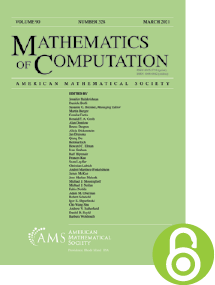Greatest of the least primes in arithmetic progressions having a given modulus
HTML articles powered by AMS MathViewer
- by Samuel S. Wagstaff PDF
- Math. Comp. 33 (1979), 1073-1080 Request permission
Abstract:
We give a heuristic argument, supported by numerical evidence, which suggests that the maximum, taken over the reduced residue classes modulo k, of the least prime in the class, is usually about $\phi (k)\log k\log \phi (k)$, where $\phi$ is Euler’s phi-function.References
- P. Erdös, On some applications of Brun’s method, Acta Univ. Szeged. Sect. Sci. Math. 13 (1949), 57–63. MR 29941
- D. R. Heath-Brown, Almost-primes in arithmetic progressions and short intervals, Math. Proc. Cambridge Philos. Soc. 83 (1978), no. 3, 357–375. MR 491558, DOI 10.1017/S0305004100054657
- Hans-Joachim Kanold, Über Primzahlen in arithmetischen Folgen, Math. Ann. 156 (1964), 393–395 (German). MR 169827, DOI 10.1007/BF01362452 E. LANDAU, Handbuch der Lehre von der Verteilung der Primzahlen, Band I, Teubner, Leipzig-Berlin, 1909. Reprinted by Chelsea, New York, 1953.
- U. V. Linnik, On the least prime in an arithmetic progression. I. The basic theorem, Rec. Math. [Mat. Sbornik] N.S. 15(57) (1944), 139–178 (English, with Russian summary). MR 0012111
- M. E. Low, Real zeros of the Dedekind zeta function of an imaginary quadratic field, Acta Arith 14 (1967/1968), 117–140. MR 0236127, DOI 10.4064/aa-14-2-117-140
- Carl Pomerance, A note on the least prime in an arithmetic progression, J. Number Theory 12 (1980), no. 2, 218–223. MR 578815, DOI 10.1016/0022-314X(80)90056-6
- K. Prachar, Über die kleinste Primzahl einer arithmetischen Reihe, J. Reine Angew. Math. 206 (1961), 3–4 (German). MR 125092, DOI 10.1515/crll.1961.206.3 G. B. PURDY, Some Extremal Problems in Geometry and the Theory of Numbers, Ph.D. thesis, University of Illinois at Urbana-Champaign, 1972.
- Andrzej Schinzel, Remark on the paper of K. Prachar “Über die kleinste Primzahl einer arithmetischen Reihe”, J. Reine Angew. Math. 210 (1962), 121–122 (German). MR 150115, DOI 10.1515/crll.1962.210.121 E. C. TITCHMARSH, "A divisor problem," Rend. Circ. Mat. Palermo, v. 54, 1930, pp. 414-429. P. TURÁN, "Über die Primzahlen der arithmetischen Progression," Acta Sci. Math. (Szeged), v. 8, 1936/37, pp. 226-235.
- Samuel S. Wagstaff Jr., The irregular primes to $125000$, Math. Comp. 32 (1978), no. 142, 583–591. MR 491465, DOI 10.1090/S0025-5718-1978-0491465-4
Additional Information
- © Copyright 1979 American Mathematical Society
- Journal: Math. Comp. 33 (1979), 1073-1080
- MSC: Primary 10H20; Secondary 10-04
- DOI: https://doi.org/10.1090/S0025-5718-1979-0528061-7
- MathSciNet review: 528061


